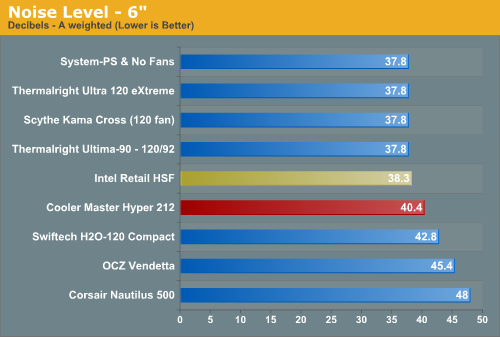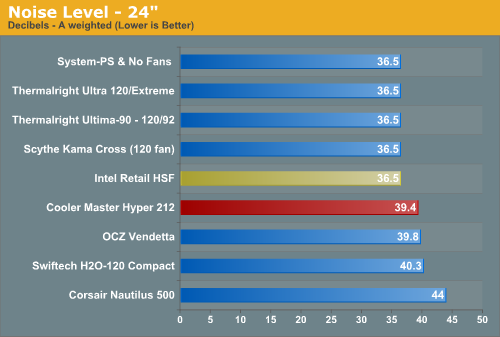Cooler Master Hyper 212: Looking for a Winner
by Wesley Fink on October 31, 2007 2:00 AM EST- Posted in
- Cases/Cooling/PSUs
Noise
For many enthusiasts upgrading cooling the goal is maximum stable overclock, and they will live with the inconvenience of a louder system. For other users silence is the most important factor, and these users will forgo maximum overclocking if that increases system noise levels.
With a specified 19 dB(A) in a 120mm form factor results should be spectacular. However, comparing the Cooler Master specifications to established low-noise performers raises many doubts about how reliable the Cooler Master specs really are.


The noise level of the included Cooler Master fan may be 19 dB(A) unmounted in a specific test environment, but the fan is definitely not silent at 12V in our noise tests. That is not to say the fan is loud, because it isn't, but it is also not silent. The mounted fan measurements are slightly above the system noise floor at both 24" and 6" from the cooler.
Subjectively, you can definitely hear the Hyper 212 fan with the case open and the fan running at 12V. Closing the case or reducing the fan RPM drops the noise to near silent. While the fan is not as quiet as the Scythe S-FLEX, it is still very quiet and will not be an issue for most users unless they are sleeping near the operating PC.
One of the problems with current cooler specs is that incredible noise claims are often made for the fans. We would much rather see a real spec of 34 dB(A) that can be confirmed in testing than a super low noise claim that turns out to be overly ambitious. In the end, we found the Hyper 212 quiet compared to many other coolers, but it is certainly not silent. However, most users will be fine with the low noise levels of the Hyper 212 fan as mounted on the heatsink.
For many enthusiasts upgrading cooling the goal is maximum stable overclock, and they will live with the inconvenience of a louder system. For other users silence is the most important factor, and these users will forgo maximum overclocking if that increases system noise levels.
With a specified 19 dB(A) in a 120mm form factor results should be spectacular. However, comparing the Cooler Master specifications to established low-noise performers raises many doubts about how reliable the Cooler Master specs really are.


The noise level of the included Cooler Master fan may be 19 dB(A) unmounted in a specific test environment, but the fan is definitely not silent at 12V in our noise tests. That is not to say the fan is loud, because it isn't, but it is also not silent. The mounted fan measurements are slightly above the system noise floor at both 24" and 6" from the cooler.
Subjectively, you can definitely hear the Hyper 212 fan with the case open and the fan running at 12V. Closing the case or reducing the fan RPM drops the noise to near silent. While the fan is not as quiet as the Scythe S-FLEX, it is still very quiet and will not be an issue for most users unless they are sleeping near the operating PC.
One of the problems with current cooler specs is that incredible noise claims are often made for the fans. We would much rather see a real spec of 34 dB(A) that can be confirmed in testing than a super low noise claim that turns out to be overly ambitious. In the end, we found the Hyper 212 quiet compared to many other coolers, but it is certainly not silent. However, most users will be fine with the low noise levels of the Hyper 212 fan as mounted on the heatsink.










21 Comments
View All Comments
thoth@cheerful.com - Saturday, September 25, 2010 - link
choppergirl;There is one fatal flaw in your example above. In your suction building you are venting the heat outside the building. and in the blower building you are not. otherwise your examples are correct. In theory the amount of heat transfer is the same for blowing or sucking the air across a heat source with all variables being equal. As one of the previous posters stated to get the variables equal IE the exact amount of air flow.It cost more on the suction set up. Needing a shroud to focus the air flow. This added cost is why manufactures blow the air instead of sucking the air. After all if cost was not one of the driving factors in your system build we would all have decked out Intel hexacore overclocked beast with liquid nitrogen cooling.